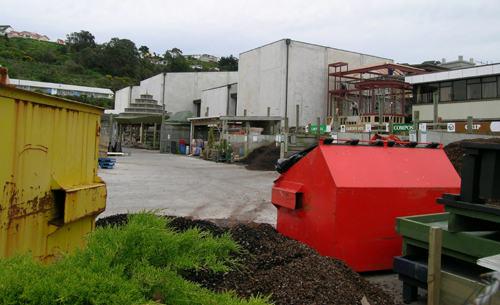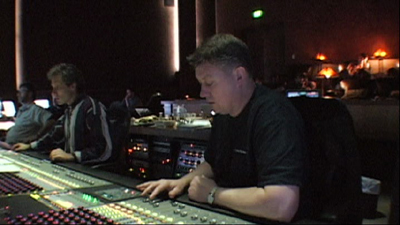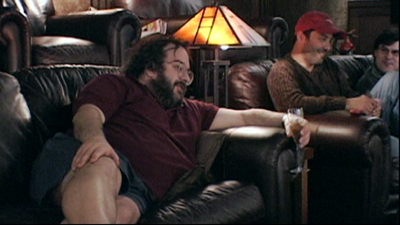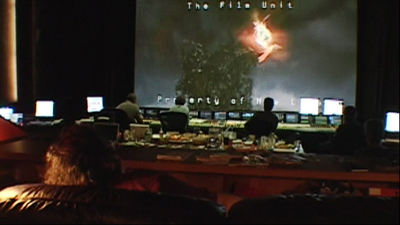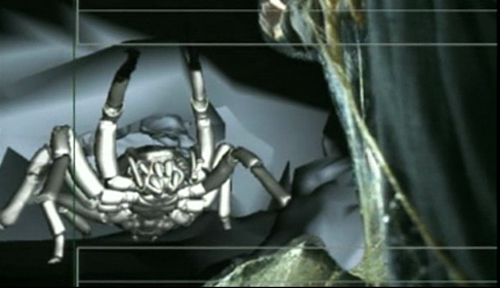Welcome back to another in my occasional series about how I did the research for my book, The Frodo Franchise: The Lord of the Rings and Modern Hollywood. (Click here to read Part 1, Part 2, Part 3, and Part 4.)
By the time I got to Wellington for my first research trip, in late September of 2003, principal photography was over. I didn’t expect that I would get to to on set and see Peter at work. In fact, Peter was in London supervising the editing and musical scoring for the first week and a half of my four-week visit. As I described in the second part of this series, I did get a delightful tour of the Stone Street Studios on my first day of active research. At that point, pickups of some orcs, destined to be inserted via CGI into battle scenes, were being shot against a big green-screen as they fired bows (the arrows to be added via computer). One of the cinematography crew members was directing this action. I was briefly in the studio again later and saw a little more filming of orc pickups. Those were my only on-set experiences.
During that one-and-a-half-week period, I conducted some of my interviews, toured facilities, and dealt with organizing my notes and recordings. Still, I had plenty of spare time between interviews. Producer Barrie Osborne, who had backed my project from the start and made it possible, let me sit in on sound-mixing sessions at Park Road Post in between appointments. Some of my interviews were in that building anyway, and as a lot of fans know, the Weta building is just a few blocks away.
At that point, Park Road Post was in the relatively early stages of being built. You’ll be familiar with that from the Return of the King extended-version supplements. The photo at the top shows the exteriors of the row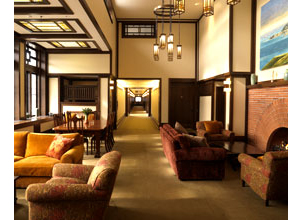 of three sound-mixing stages, the jutting parts with the slanting roofs. The building is right up against the edge of a large garden store; that pagoda-like thing is a gazebo.
of three sound-mixing stages, the jutting parts with the slanting roofs. The building is right up against the edge of a large garden store; that pagoda-like thing is a gazebo.
Despite the unfinished exterior, part of the inside of the building had been completed, including a beautiful modern-design hallway that ran past the entrances to the three sound-mixing stages. It had a lovely arched brick fireplace, a conferences table, and, tucked away off to the right in this picture, a small kitchen. Very beautiful and and at the same time cozy.
What I saw during those sound-mixing and sound-editing sessions was pretty much what is shown in the “End of All Things” supplement. The team was putting dialogue and effects (no music at that stage) into scenes that were in varying stages of completion. I remember vividly watching the scene near the beginning when Gandalf, Aragorn, Théoden, and the others ride up to Orthanc through the standing flood waters and are greeted by Treebeard. At that point it was evident that the scene had been shot in a sort of giant wading pool set up in the parking lot at Park Road Post. There was a fork lift right beside the group as the dialogue began. At intervals a title would appear that said something like “shot of Treebeard looking down.” Other scenes that I watched involved Gollum, who usually was just a shape made up of shiny silver bands rather than a fully rendered character.
Once Peter returned from London, the sound-mixing stages were off-limits to me. But as the end of my stay approached, my schedule got a little less busy, and I wished I could go back and see some more of the work on sound. Actually, sound-mixing has a reputation as being deadly dull, since it often involves the same footage being run over and over, with slight changes. I found it quite fascinating. I decided to request permission from Peter to see some more of it during my last week. I made the request through Barrie’s assistant, who relayed it to Peter’s assistant, who would relay it to him.
Peter was, to to say the least, a busy man at that point. With people on Barrie’s and Peter’s level of responsibility, their assistants prioritize items during the day that need their direct attention. Late in the day they go through as much of the stack as they have time for. Items that don’t get dealt with go back into the stack, again in order of priority. I probably started out at the bottom of the stack every day, and rightly so.
I was due to fly home on Saturday, October 25. I had my last interview on Thursday and spent Friday getting ready to go and waiting for my phone to ring, still hoping I might get to see a bit of sound-mixing. Eventually I gave up and went off to get some take-out chicken for dinner. While I was walking back, my phone rang. It was Peter’s assistant, saying I had permission to watch some sound-mixing from noon to 1 pm the next day. I was rather puzzled as to why the limit was one hour, but I gratefully said yes. My plane was due to leave at 2:30, but luckily the airport is a five-minute drive from Park Road Post, and I figured I could make it. (I mentioned in my first post that I went to New Zealand business class in order to be able to change my schedule at short notice, and that would help in getting checked in fairly quickly.)
Again, you all know from the supplements what the interiors of the mixing stages look like. Elaborate control boards for the crew, with rows of cushy brown armchairs and sofas at the back. There’s also an area of rows of theatre seats in front of the boards, though I never saw anyone sit down there. I slipped in and sat in the first chair at the far end of the last row, nearest the door, so that I could exit quietly when my hour was up.
The team was at work on the Shelob scene that day. (See the bottom of this entry. By the time I saw it, Shelob had been rendered into her final image.) After I had been observing for a little while. Barrie came in, and we waved to each other. Then Peter came in and stood by the door briefly, staring at the screen. (Yes, he was in shorts and barefoot.) I hadn’t known that he was going to be there.
At that point I realized why I had been limited to an hour. This wasn’t just sound mixing but final sound mixing, being supervised by the director. Of course I couldn’t take photos of any of this, but Peter came and sat right in front of me, in the same couch he occupies in this scene from “The End of All Things”–in the much later celebration of the film’s completion.
So the image immediately below was my point of view, except that instead of seeing Barad-dûr collapsing, we were watching Shelob chase Frodo through the tunnel. The sound had been added already, including, to my delight, Howard Shore’s score. This was the first bit of music from the film that I heard.
While I was there, Peter made two changes to the scene. He didn’t like the version of Shelob’s cry that had been chosen and asked to hear an alternative, which was the one he preferred and hence got inserted. In one shot, which showed Shelob running forward from the background, he pointed out that the sounds of her feet striking the floor of the cave didn’t get louder. He wanted the sounds to go up in volume to emphasize her getting closer to Frodo. I have to say, the sound mix in that scene was quite dense, and I was impressed that he could notice something so subtle.
About half-way through my allotted hour, Peter fell asleep. I imagine that happened fairly often during those hectic weeks, with him catching catnaps in order to be able to keep going. The team carried on. I sat there watching and thinking how incredibly lucky I was to be there. Eventually, at the end of my second visit the following year, I got to interview Peter for a full hour. That day, though, I felt that watching him direct, even just a little bit, was the perfect end to my first stay in Wellington.
I did leave promptly at 1 pm and made it to my plane.
In December, when I saw The Return of the King on Trilogy Tuesday, I was amazed at how much of the film–probably about a third of it–I had seen during the times I had sat watching the sound-mixing sessions. Those sessions remain among the high points of my first research trip.


